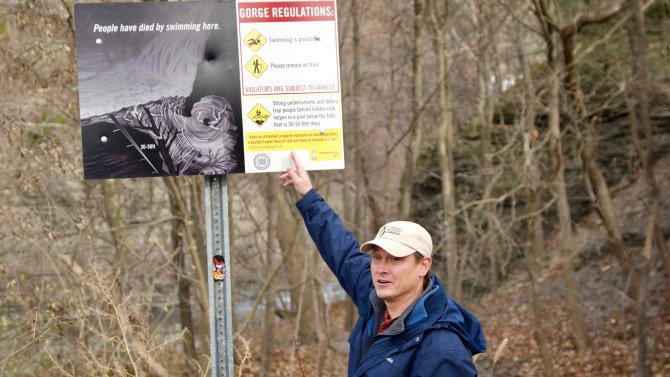Ithaca lawmakers to vote Dec. 6 on safety barrier for ‘Ezra’s Tunnel’
By Tom Fleischman
There are five safe, well-marked trails from which to experience the majesty of Fall Creek Gorge, which begins at the western end of Beebe Lake and ends at the 150-foot Ithaca Falls.
However, “Ezra’s Tunnel” – a 200-foot-long former industrial sluiceway carved through rock in the early 1830s by Ezra Cornell – is not one of them.
Despite this, many people – out of curiosity, ignorance of the dangers or a misguided sense of adventure – have used the tunnel to gain recreational access to the gorge. Accessing the creek through the tunnel is incredibly dangerous, and the consequences can be serious – and sometimes tragic.
“This area is unique in how dangerous it is, and it’s not a place for public use,” said Todd Bittner, director of natural areas for Cornell Botanic Gardens and chairman of the university’s Gorge Safety Committee. “We’re the biggest champions there are for using and enjoying the outdoors, but there are other places that people can safely and responsibly enjoy the gorges.”
On Dec. 6, Ithaca’s Common Council is scheduled to vote on whether to allow Cornell University to construct a pair of safety barriers at the west end of the tunnel. The meeting is slated for 6 p.m. in City Hall, 108 E. Green St.
One safety barrier would block access to the 12-foot-high, 13-foot-wide tunnel and include a locked gate that could be opened for gorge access by authorized personnel; the other barrier would block access to the gorge at the south end of a gap in the rock, adjacent to the tunnel, which leads to the gorge at the head of Ithaca Falls.
Both safety barriers – which would be paid for by Cornell but maintained by the city of Ithaca, on whose land the area sits – would prevent access to a dangerous area that has seen a number of tragedies over the years. Three students, including a visiting international student, lost their lives in spring and summer 2011 while swimming or off-trail hiking in Fall Creek Gorge.
Six teens had to be rescued in two incidents near the tunnel in 2015 and 2016, putting rescue personnel in harm’s way. And in August of this year, Winston Samuel Perez Ventura ’22 – who made headlines a year ago when his notification of acceptance to Cornell was captured on a viral video – drowned while swimming in the gorge near Fall Creek Drive following the Prefreshman Summer Program.
Cornell’s Gorge Safety Committee has produced a brochure detailing hiking trails in the Fall Creek, Cascadilla and Upper Cascadilla gorge system and beyond. The committee’s website has information on how to enjoy the gorges safely, the dangers therein, safe swimming options and stewardship opportunities.
Swimming is illegal in Fall Creek and Cascadilla Creek, with violators subject to arrest. In addition, off-trail hikers run the risk of falling or slipping on unstable ground, as well as being hit by falling rocks and trees.
In the wake of the three gorge deaths in 2011 – Kendrick Castro ’11 drowned in the area near the tunnel on May 30, one day after his graduation; and Nathaniel Rand ’12 (for whom the gorge safety education program is named) and Stanislaw J. Jaworski, 26, a visiting graduate student from the University of Gdansk, Poland, both died in separate Fall Creek Gorge incidents on July 2 – then-Cornell President David Skorton approved a comprehensive set of recommendations to address gorge safety.
“We identified the areas where public access in Fall Creek Gorge was safe … and created destination areas, places where people could enjoy and experience the gorges,” Bittner said. “And we closed off other areas because the dangers were too great.”
Closing Ezra’s Tunnel is part of a broader strategy that the Cornell Gorge Safety Committee, which includes city representation, has been working on to address gorge safety issues.
On Sept. 5, the city of Ithaca’s Natural Areas Commission put forth a resolution regarding restricting access to Fall Creek Gorge through the tunnel and raceway, over which water diverted from the creek flowed. The resolution’s main point: Ezra’s Tunnel is not a natural area.
“Gorge access was never the intended purpose of the tunnel or raceway, and their use has led to vandalism and dangers to users,” said Joe McMahon, chairman of the Natural Areas Commission. “It has led to several incidents requiring emergency response by the Ithaca Police Department and Ithaca Fire Department, putting a financial strain on the city.”
In early November, Ithaca’s Planning and Economic Development Committee voted, 3-1, to send the resolution regarding the safety barriers to Common Council for a final vote.
Bittner insists the committee’s goal isn’t to restrict people’s access to natural areas – it’s all about safety.
“There aren’t that many places where you can actually physically close a place quite like we’re able to at Ezra’s Tunnel,” he said. “The construction of safety barriers is a very cost-effective way of addressing this. And it will save lives, undoubtedly.”
Media Contact
Get Cornell news delivered right to your inbox.
Subscribe